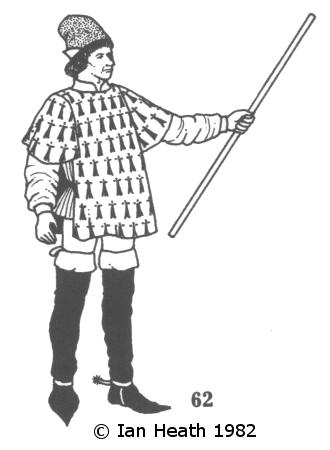
Create an Amazon Business Account
HERALD
An extract from Armies of the Middle Ages, volume 1by Ian Heath



62. HERALD
The term 'herald' only first appeared in that form during the second half of the 14th century (though its Old French form of herault was in use considerably earlier, and the first reference to a herald being present on the battlefield dates to 1173). Their duties on the battlefield, where they were granted total immunity, were to bear messages; arrange truces; to identify the enemy by his flags; to record those dubbed knights and those who fought bravely on both sides; and to identify those who fled and the corpses of the slain.
Their various ranks comprised, in descending order, kings of arms (or of heralds), marshals of arms (a title not often encountered), heralds, and pursuivants. Nicholas Upton, who wrote before 1446, says that heralds were chosen from pursuivants of at least 7 years' standing, these in turn being chosen from horsemen with 3 years experience in riding. Pursuivants were often distinguished by wearing the tabard askew (i.e. with the longer flaps over the arms), as for example in France and England. Heralds could be retained in considerable numbers, the future King John II having in 1347, as Duc de Normandie, 5 kings of arms and 21 heralds in his retinue. Even captains of Free Companies often had their own herald or pursuivant, though these were generally looked upon with disdain by other heralds.
This figure, from the same source as the last, represents the king of arms of the Duc de Bretagne. He wears the ermine tabard of Brittany over a green tunic and red undershirt. His cap and hose are likewise red, and he wears tall black riding boots turned down on the thigh. Note his white staff or wand, carried by heralds as a symbol of office.
Officially heralds were unarmed, but contemporary pictures often show a dagger or short sword worn at the hip, while in battle a mail corselet was generally worn under the tabard.